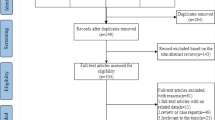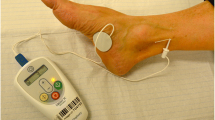Abstract
Aim
Transcutaneous electrical nerve stimulation (TENS) is a possible alternative to sacral nerve stimulation because the neurophysiologic targets might be similar but the former method is non-invasive and cheaper. The aim of the study was to assess both symptom and quality of life (QoL) improvements in patients suffering from severe FI.
Methods
Thirty two patients (M/F, 30/2; age, 61 ± 13 years) were enrolled in a pilot trial because they suffered from a severe and stable FI (Cleveland Score14.5 ± 2.8 [11–20]) for a long duration (95 ± 91 months). TENS was delivered 20 min bis in die at home (Schwa Medico, P3). Assessment was realized at 1, 3, and 6 months with both semi-directive and self-administered questionnaires. Main endpoint was the quantified success rate after 1 month of follow-up.
Results
Mean subjective improvement was 26 ± 30%: 20 (63%) patients reported some degree of improvement and 10 (32%) at least a 25% improvement in fecal incontinence. The Cleveland score significantly decreased at 1 (11 ± 4; p < 0.001), 3 (11 ± 5; p < 0.001), and 6 (10 ± 5; p < 0.001) months. All subscales of QoL were significantly improved after a 3-month period of stimulation. However, constipation score and number of pads did not change. There was no adverse event.
Conclusion
TENS provides slight improvement in FI. This justifies both neurophysiology assessment and randomized controlled studies before further diffusion of the technique.


Similar content being viewed by others
References
van Balken M, Vegunst H, Bemelmans BLH (2004) The use of electrical devices for the treatment of bladder dysfunction: a review of methods. J Urol 172:846–851
Nakamura M, Sakurai T, Tsujimoto Y, Tada Y (1983) Transcutaneous electrical stimulation for the control of frequency and urge incontinence. Hinyokika Kiyo 29:1053–1059
Chang PL (1988) Urodynamic studies in acupuncture for women with frequency, urgency and dysuria. J Urol 140:563–566
Amarenco G, Ismael SS, Even-Schneider A, Raibaut P, Demaille-Wlodyka S, Parratte B, Kerdraon J (2003) Urodynamic effect of acute transcutaneous posterior tibial nerve stimulation in overactive bladder. J Urol 169:2210–2215
Shafik A, Ahmed I, El-Sibai O, Mostafa RM (2003) Percutaneous peripheral neuromodulation in the treatment of fecal incontinence. Eur Surg Res 35:103–107
Queralto M, Portier G, Cabarrot PH et al (2006) Preliminary results of peripheral transcutaneous neuromodulation in the treatment of idiopathic fecal incontinence. Int J Colorectal Dis 21:672–674
Vaizey CJ, Carapeti E, Cahill JA, Kamm MA (1999) Prospective comparison of faecal incontinence grading systems. Gut 44:77–80
Rullier E, Zerbib F, Marrel A, Amouretti M, Lehur PA (2004) Validation of the French version of the Fecal Incontinence Quality-of-Life(FIQL) scale. Gastroenterol Clin Biol 28:562–568
Damon H, Dumas P, Mion F (2004) Impact de l’incontinence et de la constipation sur la qualité de vie. Gastroenterol Clin Biol 28:16–20
Bosch JLHR (2006) Electrical neuromodulatory therapy in female voiding dysfunction. BJU Int 98:S43–S48
Blok B, Groen J, Veltman D, Bosch R, Lammertsma A (2003) Brain plasticity and urge incontinence: PET studies during the first hours of sacral neuromodulation. Neurourol Urodyn 22:490–491
Vodusek DB, Light JK, Libby JM (1986) Detrusor inhibition induced by stimulation of pudendal nerve afferents. Neurourol Urodyn 5:381
Siproudhis L, Pigot F, Godeberge P, Damon H, Soudan D, Bigard MA (2006) Defecation disorders: a French population survey. Dis Colon Rectum 49:219–227
van Balken MR, Vandoninck V, Gisolf KW et al (2001) Posterior tibial nerve stimulation as neuromodulative treatment of lower urinary tract dysfunction. J Urol 166:914–918
Nuhoglu B, Fidan V, Ayyildis A, Ersoy E, Germiyanoglu C (2006) Stoller afferent nerve stimulation in woman with therapy resistant over active bladder; a 1-year follow up. Int Urogynecol J 17:204–207
Malm-Buatsi E, Nepple KG, Boyt MA, Austin C, Cooper CS (2007) Efficacy of transcutaneous electrical nerve stimulation in children with overactive bladder refractory to pharmacotherapy. Urology 70:980–983
van der Pal F, van Balken MR, Heesakkers JP, Debruyne FM, Bemelmans BL (2006) Percutaneous tibial nerve stimulation in the treatment of refractory overactive bladder syndrome: is maintenance treatment necessary? BJU Int 97:547–550
Financial disclosure
None.
Author information
Authors and Affiliations
Corresponding author
Rights and permissions
About this article
Cite this article
Eléouet, M., Siproudhis, L., Guillou, N. et al. Chronic posterior tibial nerve transcutaneous electrical nerve stimulation (TENS) to treat fecal incontinence (FI). Int J Colorectal Dis 25, 1127–1132 (2010). https://doi.org/10.1007/s00384-010-0960-3
Accepted:
Published:
Issue Date:
DOI: https://doi.org/10.1007/s00384-010-0960-3




